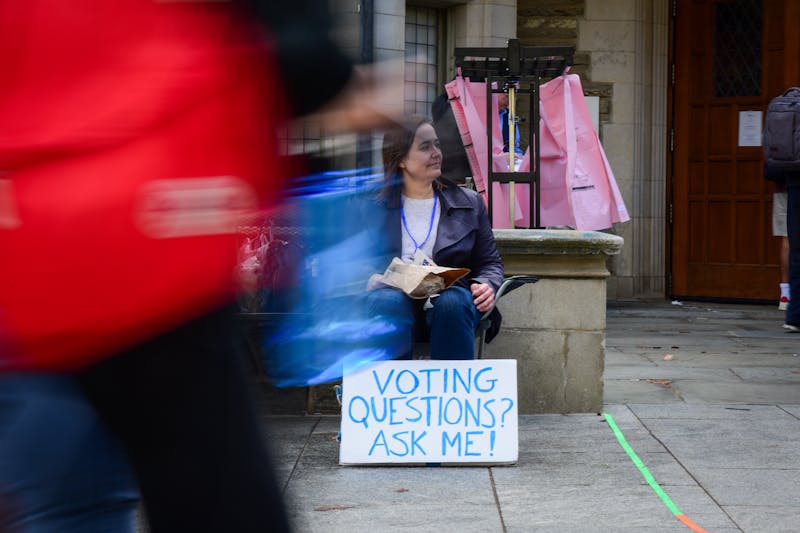
Anyone who steps on Locust Walk immediately understands what it means for campus to be buzzing. Whether students are rushing to class, grabbing a bite to eat, lounging in the grass, or studying with friends, the back-to-school chaos has certainly set in. And while post-pandemic crowds are certainly an enjoyable experience for our socially-deprived community, one cannot deny the difficulty and inconvenience of navigating such a hectic environment.
Especially in dining halls that thousands of students are required to eat at, squeezing in meals between classes and extracurricular activities is often difficult. In the past, dining halls predominantly consisted of first years who were required to be on the dining plan, with the addition of select upperclassmen who chose on-campus dining. Now, with the second-year dining plan required for all sophomore students, more than two full classes of students suffer long lines and battle for available seats and reservations. At sit-down dining halls, there have been many instances of food running out an hour before closing, and often paper plates and plastic utensils must be used because dishes cannot be washed quickly enough. One has to guess if this is largely due to Penn operating dining halls in the same fashion as before without considering the fact that there are literally double the amount of students eating on campus than prior years.
More pressing issues occur in market-style dining halls, such as Houston Market and the 1920 Commons Starbucks, where long lines and wait times are inevitable. While this is partially due to the popularity of such locations, the confusion of both in-person and mobile PennEats orders is also to blame. For example, Starbucks customers can witness the printing of a never-ending mobile order receipt chain, while a physical line simultaneously wraps around the cafe. Instead of waiting 15-20 minutes like the app predicts, wait times can extend to two times as long during peak meal times. It is not uncommon to see students repeatedly ask for their order status as they anxiously check the time before eventually giving up and sprinting to class. There have been many instances where students have no choice but to forfeit meals and attend class hungry in an attempt to arrive on time. Furthermore, students are not allowed to eat in class anymore due to mask restrictions, so for students with back-to-back classes, there are only 15 minutes to walk to a dining hall, get food, finish eating, and walk back to class.
The system is even more unfair to dining hall workers who work tirelessly to fulfill student demands, as they not only have to deal with frustrated and demanding teenagers, but also the stressful responsibility of completing an influx of both online and in-person orders in a timely fashion. When Starbucks’ mobile order receipt chain hits the floor, it is impossible for the staff to complete orders within the promised wait time period.
Besides for crowds and occasional food and dish shortages, sit-down dining halls have been more successful in accommodating students. This proves that the combination of in-person and mobile ordering is the more prevalent cause of disaster. Therefore, Penn should provide only one option for meal-ordering to minimize confusion and prevent staff stress. Some might argue that the implementation of only one option for ordering would result in longer lines or longer wait times, but in this system orders would actually be processed more efficiently since the staff’s entire focus would be dedicated to one stream of orders. Prioritization would also provide students with a better understanding of when their orders would be ready and how much time they would be waiting for food.
Utilizing either in-person or mobile ordering only would increase both student and staff satisfaction and productivity. Furthermore, if the latter were to become the sole policy, the potential for COVID-19 spreading would be reduced. Similar to last semester, ordering food ahead of time is an efficient way for students to eat according to their own schedules. Familiarizing students with ordering through the app early in the semester is important in preparing for any potential changes due to the pandemic, especially for first-years who do not necessarily know how to use the PennEats app.
Addressing the hectic, stressful nature of the dining halls is therefore not only important for the sake of student convenience and staff well-being, but also for COVID-19 preparedness. While everyone seeks to preserve the bustling nature of campus, it is important to be mindful of how such chaos affects the community.
EMILY CHANG is a College sophomore studying sociology from Holmdel, N.J. Her email address is changem@sas.upenn.edu.
The Daily Pennsylvanian is an independent, student-run newspaper. Please consider making a donation to support the coverage that shapes the University. Your generosity ensures a future of strong journalism at Penn.
Donate






